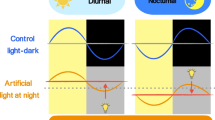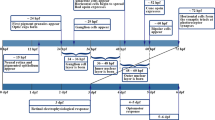Summary
-
1.
Surgical sections or smaller chemical lesions made in the optic tract of one eye of the crayfish,Procambarus clarkii, lead to loss of the ERG amplitude rhythm in the operated eye while the intact eye continued to oscillate in constant darkness (Fig. 2). Apparent recovery of generally lower amplitude oscillations after surgery did, however, occur in 7 out of 17 preparations tested (Fig. 6).
-
2.
Only lesions which included the central part of the optic tract resulted in a loss of rhythmicity (Fig. 1). Ultrastructure of this region of the optic tract showed axons with dense core vesicles and blood vessels; however, presumptive neurosecretory axons were not confined to this region (Fig. 3, 4).
-
3.
Tests for circulatory patency of the lesioned optic system were made by injecting eyestalk hormone extracts. Such injections caused depression of the ERG amplitude of both the operated and unoperated eye indicating that exogenous (and presumable endogenous) hormone reached the retina. Hormone injections, however, failled to alter the phase of the rhythm (Fig. 5).
-
4.
Low level unilateral retinal illumination in an animal with intact optic tracts successfully entrained the ERG rhythm in both eyes (Fig. 7).
-
5.
In operated animals unilateral illumination of the neurally isolated retina failed to entrain the intact contralateral side as evidenced by the fact that the intact side free-ran throughout the 13 days of attempted entrainment (Fig. 8A).
-
6.
Transfer of the entraining light to the intact retina phase-shifted its rhythm, while the operated eye became phase-locked to and appeared to be driven by the intact side (Fig. 8B).
-
7.
A summary diagram is provided which details the known coupling components of this circadian system (Fig. 9). Both hormonal and neural coupling appear to synchronize retinal sensitivity in the two eyes. Although the hormonal contribution is substantial, preliminary evidence indicates that their titers are driven by the underlying clock rather than comprising an integral part of the oscillator itself (Fig. 5).
Similar content being viewed by others
Abbreviations
- C.E.C. :
-
circumesophageal connective
- DD :
-
constant darkness
- DPLH :
-
distal pigment light adapting hormone
- ERG :
-
electroretinogram
- LED :
-
light emitting diode
- LD :
-
light-dark cycle
- lx :
-
Lux
- NDH :
-
neural depressing hormone
- O.T. :
-
optic tract
- P.R. :
-
photoreceptor
- SG :
-
sinus gland
- XO :
-
x-organ
References
Andrew, R.D., Orchard, I., Saleuddin, A.S.M.: Structural re-evaluation of the neurosecretory system in the crayfish eyestalk. Cell Tissue Res.190, 235–246 (1978)
Andrew, R.D., Saleuddin, A.S.M.: Structure and innervation of a crustacean neurosecretory cell. Can. J. Zool.56, 423–430 (1978)
Aréchiga, H.: Modulation of visual input in the crayfish. In: Identified neurons and behavior of arthropods. Hoyle, G. (ed.), pp. 387–403. New York, London: Plenum Press 1977
Aréchiga, H., Fuentes, B.: Correlative changes between retinal shielding pigments position and electroretinogram in crayfish. Physiologist13, 137 (1970)
Aréchiga, H., Mena, F.: Circadian variations of hormonal content in the nervous system of the crayfish. Comp. Biochem. Physiol.52A, 581–584 (1975)
Aréchiga, H., Wiersma, C.A.G.: Circadian rhythm of responsiveness in crayfish visual units. J. Neurobiol.1, 71–85 (1969)
Aréchiga, H., Fuentes, B., Barrera, B.: Circadian rhythm of responsiveness in the visual system of the crayfish. In: Neurobiology of invertebrates. Salanki, J. (ed), pp. 403–421. Budapest: Hungarian Academy of Sciences 1973
Aréchiga, H., Huberman, A., Martinez-Palomo, A.: Release of neurodepressing hormone from the crustacean sinus gland. Brain Res.128, 93–108 (1977)
Barrera-Mera, B.: Effects of cerebroid ganglion lesions on ERG circadian rhythm of the crayfish. Physiol. Behav.17, 59–64 (1976)
Barrera-Mera, B.: Neural coupling between left and right electroretinographic circadian oscillations in the crayfishP. bouveri. Comp. Biochem. Physiol.61A, 427–432 (1978)
Barrera-Mera, B., Berdeja-Garcia, G.Y.: Bilateral effects on retinal shielding pigments during monocular photic stimulation in the crayfish,Procambarus. J. Exp. Biol.79, 163–168 (1979)
Bennitt, R.: Diurnal rhythm in the proximal pigment cells of the crayfish retina. Physiol. Zool.5, 65–69 (1932)
Bittner, G.D., Ballinger, M.L., Larimer, J.L.: Crayfish CNS: Minimal degenerative-regenerative changes after lesioning. J. Exp. Zool.189, 13–36 (1974)
Bliss, D.E., Durand, J.B., Welsh, J.H.: Neurosecretory systems in decapod Crustacea. Z. Zellforsch.39, 520–536 (1954)
Bunt, A.H., Ashby, E.A.: Ultrastructure of the sinus gland of the crayfish,Procambarus clarkii. Gen. Comp. Endocrinol.9, 334–342 (1967)
Harreveld, Van A.: A physiological solution for freshwater crustaceans. Proc. Soc. Exp. Biol.34, 428–432 (1936)
Iwasaki, S., Satow, Y.: Electral characteristics of the membrane in neurosecretory neurons. In: Neuroendocrine control. Yagi, K., Yoshida, S. (eds.), pp. 86–109. New York: John Wiley 1973
Jaros, P.P.: Tracing of neurosecretory neurons in crayfish optic ganglia by cobalt iontophoresis. Cell Tissue Res.194, 297–302 (1978)
Kleinholz, L.H.: Hormonal regulation of retinal pigment migration in crustaceans. In: functional organization of the compound eye. Bernard, C.G. (ed.), pp. 89–101. Oxford: Pergamon Press 1966
Kleinholz, L.H.: Crustacean neurosecretory hormones and physiological specificity. Am. Zool.16, 151–166 (1976)
Ludolph, C., Pagnanelli, D., Mote, M.I.: Neural control of migration of proximal screening pigment by retinular cells of the swimming crabCallinectes sapidus. Biol. Bull.145, 159–170 (1973)
Nunnemacher, R.F.: The fine structure of optic tracts of Decapoda. In: International Symposium on the Functional Organization of the Compound Eye. Bernard, C.G. (ed.), pp. 363–375. London: Pergamon Press 1966
Page, T.L., Larimer, J.L.: Neural control of circadian rhythmicity in the crayfish II. The ERG amplitude rhythm. J. Comp. Physiol.97, 81–96 (1975)
Page, T.L., Larimer, J.L.: Extraretinal photoreception in entrainment of crustacean circadian rhythms. Photochem. Photobiol.23, 245–251 (1976)
Sanchez, J.A., Fuentes-Pardo, B.: Circadian rhythm in the amplitude of the electroretinogram in the isolated eyestalk of the crayfish. Comp. Biochem. Physiol.56A, 601–605 (1977)
Smith, J.T., Larimer, J.L.: Fibers in the optic tract of crayfish are necessary for the expression of a circadian rhythm in the amplitude of the ERG. Fed. Proc.36, 581 (1977)
Welsh, J.: The sinus gland and 24 hour cycles of retinal pigment migration in the crayfish. J. Exp. Zool.86, 35–49 (1941)
Williams, B.J., Larimer, J.L., Gordon, W.H.: Production of localized lesions in the nervous system using silver nitrate. Comp. Biochem. Physiol.57A, 37–40 (1977)
Williams, J.A., Pullin, S.V., Williams, B.G., Aréchiga, H., Naylor, E.: Evaluation of the effects of injected eyestalk extract on rhythmic locomotor activity inCarcinus. Comp. Biochem. Physiol.62A, 903–907 (1979)
Author information
Authors and Affiliations
Additional information
The authors wish to thank Ann Williams, Cathy Welch and Diane Nicholl for their technical assistance. We are grateful for the expertise of Martis Ballinger and especially Robert Riess in preparing the electron micrographs. We also wish to acknowledge the efforts of Ernie Hernandez and Rodney Wood in building electronic apparatus used in this work. This research was supported by a grant from the National Institutes of Health, NIH NS-05423.
Rights and permissions
About this article
Cite this article
Larimer, J.L., Smith, J.T.F. Circadian rhythm of retinal sensitivity in crayfish: Modulation by the cerebral and optic ganglia. J. Comp. Physiol. 136, 313–326 (1980). https://doi.org/10.1007/BF00657351
Accepted:
Issue Date:
DOI: https://doi.org/10.1007/BF00657351




